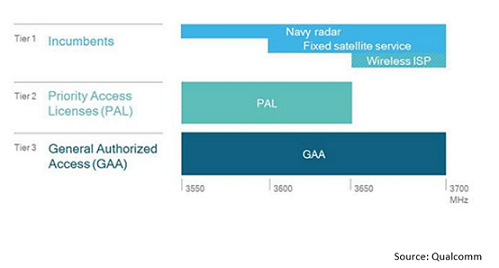CBRS: Cable Operators and Wireless Services
By Chris Bastian
Senior Vice President, Engineering & CTO
SCTE-ISBE
Cable network operators are traditionally known for operating wireline access networks, as in building and maintaining the cable run from their network to your home. While this cable access segment is still vitally important to providing reliable services, 21st century consumers have become increasingly used to using their services on the go via a wireless access network, or WAN. To facilitate this mobility, cable network operators have made independent decisions to:
- build and offer Wi-Fi in residential, business, and public hotspots,
- build and offer 4G/cellular, and/or
- negotiate an MVNO deal with a 4G/cellular provider.
Consumers really don’t care what radio frequencies their services are carried across as long as the resultant service is fast and reliable. The cable operators have a distinct advantage to offering wireless service because they operate the wireline network necessary to underpin the wireless network. Every robust and reliable wireless network is dependent on a ubiquitous and reliable wireline network. As wireless networks rapidly move toward 5G in the coming years, their cell site penetration will become denser and closer to the consumer, yielding the need for ever-more-present wireline networks.
The new kid on the wireless block is Citizens Broadband Radio Service (CBRS). CBRS is 150 MHz of spectrum in the 3.5 to 3.7 GHz band. It is envisioned that the CBRS band will be used for rapidly deploying 5G services and will significantly lower the barrier to entry for a wide range of operators who may not be currently in the LTE network business. Besides conventional small cell coverage, CBRS will support Fixed Wireless Access and private LTE networks, opening up more opportunities for the cable industry to offer wireless service.
The Federal Communications Commission issued rules (FCC Part 96) for use of the CBRS band in 2017. Fundamental to the FCC rules is a three-tier authorization structure:
- The Incumbent Access tier includes Federal and grandfathered Fixed Satellite Service users, and this tier will be protected from interference from the other two tiers.
- The Priority Access tier is limited from 3550 MHz to 3650 MHz, and it will be licensed by the FCC and awarded by competitive bidding. Each priority access license (PAL) will be for a 10 MHz channel within the band, and the license will be for three years. These users must not cause harmful interference to Incumbent Access users and should expect interference protection from General Authorized Access users.
- The General Authorized Access tier is intended to serve the widest group of users. These users are allowed to use any portion of the band not in use by the other two tiers. These users should not expect interference protection from other General Authorized Access users; however, they must not cause harmful interference to, and must accept interference from, Priority Access licensees and Incumbent Access users.
Access and operations of the CBRS band will be managed by a Spectrum Access System (SAS), in accordance with the FCC rules. The primary roles of the SAS will be to accept user requests to register against their specific access tier and to authorize when a user’s device can transmit across a specific frequency.

Two industry bodies, the Wireless Innovation Forum and the CBRS Alliance, have been focused on making the new CBRS spectrum available to consumers. The WInnForum lists its membership at more than 60 companies and, through its Spectrum Sharing Committee, is creating standards that support the sharing technologies based on the three-tier architecture. The CBRS Alliance also lists 60 companies as its membership and is focused on certifying equipment for rapid deployment in the CBRS band.
CBRS will be heavily featured at this year’s SCTE•ISBE Cable-Tec Expo®, with five speakers addressing the topic. Scheduled from Monday, Oct. 22 through Thursday, Oct. 25 at Atlanta’s Georgia World Congress Center, Cable-Tec Expo is renowned as the pre-eminent venue that combines the thought leadership, engineering innovation, and deal-making that power the technological future of broadband telecommunications. Registration for SCTE•ISBE Cable-Tec Expo 2018 is available at expo.scte.org/attendee-registration.